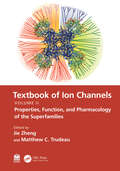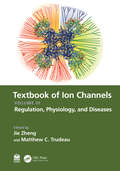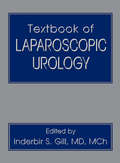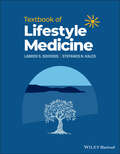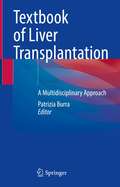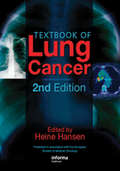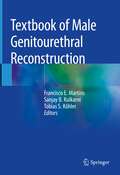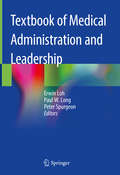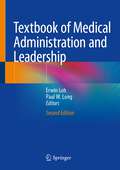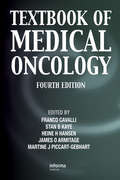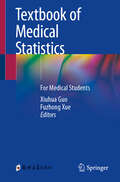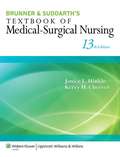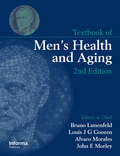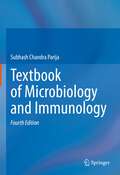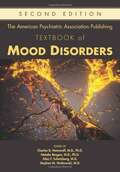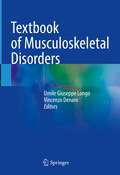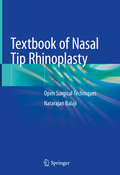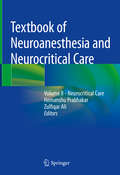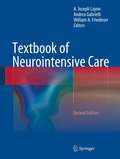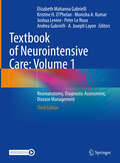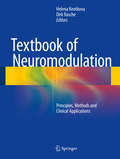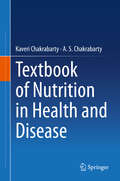- Table View
- List View
Textbook of Ion Channels Volume II: Properties, Function, and Pharmacology of the Superfamilies
by Jie Zheng and Matthew C. TrudeauThe Textbook of Ion Channels is a set of three volumes that provides a wide-ranging refer- ence source on ion channels for students, instructors and researchers. Ion channels are membrane proteins that control the electrical properties of neurons and cardiac cells; mediate the detection and response to sensory stimuli like light, sound, odor, and taste; and regulate the response to physical stimuli like temperature and pressure. In non-excit- able tissues, ion channels are instrumental for the regulation of basic salt balance that is critical for homeostasis. Ion channels are located at the surface membrane of cells, giving them the unique ability to communicate with the environment, as well as the membrane of intracellular organelles, allowing them to regulate internal homeostasis. Ion channels are fundamentally important for human health and diseases, and are important targets for pharmaceuticals in mental illness, heart disease, anesthesia, pain and other clinical appli- cations. The modern methods used in their study are powerful and diverse, ranging from single ion-channel measurement techniques to models of ion channel diseases in animals, and human clinical trials for ion channel drugs. Volume II starts with ion channel taxonomy and features coverage of major ion channel families, and describes the physiological role, structural components, gating mechanisms and biophysics, permeation and selectivity, regulation, pharmacology, and roles in dis- ease mechanisms. Channels in this volume include voltage-activated sodium, calcium and potassium channels, inward-rectifier and two-pore domain potassium channels, calcium- activated potassium channels, cyclic nucleotide-gated channels, pacemaker ion channels, chloride channels, ligand-gated receptors activated by acetylcholine, glutamate, 5-HT3, GABA and glycine, acid-sensing channels, P2X receptors, TRP channels, store-operated channels, pressure-activated piezo channels, ryanodine receptors, and proton channels. All three volumes give the reader an introduction to fundamental concepts needed to understand the mechanism of ion channels; a guide to the technical aspects of ion channel research; offer a modern guide to the properties of major ion channel families; and include coverage of key examples of regulatory, physiological and disease roles for ion channels.
Textbook of Ion Channels Volume III: Regulation, Physiology, and Diseases
by Jie Zheng and Matthew C. TrudeauThe Textbook of Ion Channels is a set of three volumes that provides a wide-ranging reference source on ion channels for students, instructors and researchers. Ion channels are mem- brane proteins that control the electrical properties of neurons and cardiac cells; medi- ate the detection and response to sensory stimuli like light, sound, odor, and taste; and regulate the response to physical stimuli like temperature and pressure. In non-excitable tissues, ion channels are instrumental for the regulation of basic salt balance that is critical for homeostasis. Ion channels are located at the surface membrane of cells, giving them the unique ability to communicate with the environment, as well as the membrane of intracellular organelles, allowing them to regulate internal homeostasis. Ion channels are fundamentally important for human health and diseases, and are important targets for pharmaceuticals in mental illness, heart disease, anesthesia, pain and other clinical appli- cations. The modern methods used in their study are powerful and diverse, ranging from single ion-channel measurement techniques to models of ion channel diseases in animals, and human clinical trials for ion channel drugs. Volume III includes coverage of key ion channel regulators and their mechanisms, the role of ion channels working in concert in selected physiological systems, and examples of ion channel mutations and dysfunction in a selection of diseases. Chapters on ion channel regulation include splice variants, calcium–calmodulin regulation, regulation by G pro- teins, and lipids. A selection of ion channels in physiological systems includes ion chan- nels of the heart, ion channels in immune cells and their role in pancreatic beta cells and regulation of insulin secretion, and the role of channels in sperm and eggs. While disease mechanisms are integrated into the chapters of Volume II, Volume III offers special consid- eration of ion channels in epilepsy, cystic fibrosis and pain syndromes. All three volumes give the reader an introduction to fundamental concepts needed to understand the mechanism of ion channels, a guide to the technical aspects of ion channel research, offer a modern guide to the properties of major ion channel families, and includecoverage of key examples of regulatory, physiological, and disease roles for ion channels.
Textbook of Laparoscopic Urology
by Inderbir S. GillDivided into eleven detailed sections, this reference displays the expertise and research of specialists from leading urology centers around the world and offers authoritative chapters on the entire spectrum of urologic laparoscopy. The chapters cover methods in patient selection, peri-operative management, and complication avoidance; step-by-step
Textbook of Lifestyle Medicine
by Labros S. Sidossis Stefanos N. KalesTextbook of Lifestyle Medicine The Textbook of Lifestyle Medicine provides foundational knowledge essential to students and scientists across various disciplines to better understand this new area of research and practice. Incorporating the latest evidence-based research on the relationships between lifestyle factors and disease, this unique book discusses the practical tools necessary to address growing public health crises such as obesity, cancer, diabetes, and cardiovascular disease using a holistic approach to physical, mental, and spiritual wellness. The book offers comprehensive and up-to-date coverage of how lifestyle medicine professionals can prevent and mitigate ‘Lifestyle Diseases’. Clear and accessible chapters explore modifiable lifestyle factors that positively affect health, nutrition, exercise, sleep, stress control, and social support, and highlight the negative impact of smoking, alcohol abuse, and other unhealthy lifestyles. Topics include sleep physiology, the genetic background and development of noncommunicable diseases (NCDs), the characteristics and principles of healthy lifestyle, the clinical significance of physical activity, and the mechanisms connecting social interaction and health implications. This important resource: Discusses the global burden and risk factors of the modern disease epidemic Covers a variety of nutritional approaches including the Mediterranean Diet and the Dietary Approaches to Stop Hypertension (DASH) diet Features in-depth coverage of the Mediterranean Lifestyle, a holistic approach to health and wellness Includes a clinical practice section and appendices on preventive medicine and public health tools and recommendations Contains key points, take-home messages, self-assessment questions, color artwork and numerous references, citations, internet links, and further reading suggestions Written by two world experts in this growing field, the Textbook of Lifestyle Medicine is a must-have volume for students and practitioners in nutrition, exercise physiology, psychology, addiction therapy, sleep therapy, as well as physicians, nurses, and other health professionals wanting to expand their knowledge and practice.
Textbook of Liver Transplantation: A Multidisciplinary Approach
by Patrizia BurraLiver transplantations require a complex and varied, multidisciplinary approach involving not only hepatologists and surgeons but also pathologists, psychologists, professional educators, nurses and, in the case of young patients, also pediatricians and development experts. This textbook provides an overview of the management problems involved in liver transplantation for acute and chronic liver disease, pediatric liver transplantation and the psychosocial aspects of liver transplantation. A closing chapter, focusing on the developments and future prospects in liver transplantation, outlines the potential offered by donors after cardiac death, cell therapies and organogenesis. The multidisciplinary approach is also maintained in the selection of authors, all experts actively engaged in the various disciplines involved in liver transplantations. This aspect, together with its precise and didactic descriptions of all phases of liver transplantation for chronic and acute diseases – from managing waiting lists to post-transplant complications – make the book a valuable tool for fellows, trainees, and specialists in the field seeking accurate framework for liver transplantation in its many facets.
Textbook of Lung Cancer
by Heine Hansen MD FRCPTextbook of Lung Cancer, 2nd edition, published in association with the European Society of Medical Oncology, is a comprehensive and multidisciplinary text, which examines all aspects of this disease, with contributions from a multinational team of authors on etiology, epidemiology, molecular biology, pathology, smoking, detection and manage
Textbook of Male Genitourethral Reconstruction
by Tobias S. Köhler Francisco E. Martins Sanjay B. KulkarniThis textbook provides a guide to reconstructive surgery of genitourethral problems in male patients. The first section covers all aspects of urethral reconstruction, including the functional anatomy of the urethra, etiology, epidemiology, and demographic differences in urethral pathology. The second section focuses on surgical reconstruction of penile and scrotal anomalies and dysfunctions. Textbook of Male Genitourethral Reconstruction aims to aid the management of male genitourethral reconstruction patients by reviewing the recent advancements in technology and surgical technique. This book is relevant to urologists, plastic and reconstructive surgeons, medical students, and health care professionals working within urology and plastic surgery.
Textbook of Medical Administration and Leadership
by Erwin Loh Paul W. Long Peter SpurgeonThis textbook covers all general areas of knowledge required for a trainee, generalist medical administrator, and doctor undergoing training to be a medical administrator specialist. Chapters cover all the key topics on medical administration and leadership. Some of the key topics included are: health systems and policy, health law, private health and insurance, health disaster planning, population and public health, health information and technology, and health economics and financial management. Medical practitioners of today are part of huge changes in medical practice as continuing developments are happening in biomedical sciences and clinical practice with new health priorities, rising expectations among patients and the public, and changing societal attitudes. Consequently, basic knowledge and skills, while fundamentally important are not enough today on their own and doctors thus need to demonstrate leadership combined with sound management skills to drive the necessary changes required to meet the challenges head. This book serve as an invaluable resource for a wide spectrum of physicians including specialists, clinician managers and other health professionals, as well as non-clinical managers working in health. This is a gateway text for trainees in medical administration, specialist medical administrators, aspiring medical managers, health service managers, and heads of service and departments in various medical specialties.
Textbook of Medical Administration and Leadership
by Erwin Loh Paul W. LongThis textbook covers all general areas of knowledge required for a trainee, generalist medical administrator, and doctor undergoing training to be a medical administrator specialist. Chapters cover all the key topics on medical administration and leadership. Some of the key topics included are: health systems and policy, health law, private health and insurance, health disaster planning, population and public health, health information and technology, and health economics and financial management.Medical practitioners of today are part of huge changes in medical practice as continuing developments are happening in biomedical sciences and clinical practice with new health priorities, rising expectations among patients and the public, and changing societal attitudes. Consequently, basic knowledge and skills, while fundamentally important are not enough today on their own and doctors thus need to demonstrate leadership combined with sound management skills to drive the necessary changes required to meet the challenges head. This book serve as an invaluable resource for a wide spectrum of physicians including specialists, clinician managers and other health professionals, as well as non-clinical managers working in health. This is a gateway text for trainees in medical administration, specialist medical administrators, aspiring medical managers, health service managers, and heads of service and departments in various medical specialties.
Textbook of Medical Oncology
by Franco Cavalli James O. Armitage Heine H. Hansen Stan B. Kaye Martine J. Piccart-GebhartEffective care of the cancer patient increasingly involves systemic treatment, and as the range of available therapeutic agents continues to expand, the medical oncologist must be fully aware of the rationale for choosing specific drugs and combinations. Textbook of Medical Oncology, 4th edition, is written by a highly acclaimed list of internation
Textbook of Medical Statistics: For Medical Students
by Xiuhua Guo Fuzhong XueThis book introduces basic concepts, principle, and methods of medical statistics systematically and practically, especially in the statistical design of the experiment in terms of the specific problems, adequate use of statistical methods based on actual data and the reasonable explanation for statistical results.This textbook combines statistical methods with the common application of SPSS software, which is flexible, convenient, and user-friendly; thus, students can focus on the deep understanding of statistics.The authors emphasize the application and generalization of statistical methods, and combine these methods with the modern statistical theory, such as sequential contingency table and multivariate statistical modelling, etc.This book is a useful textbook for graduate and undergraduate students in medical schools, including MBBS (Bachelor of Medicine and Bachelor of Surgery) student.
Textbook of Medical-Surgical Nursing (Thirteenth Edition)
by Janice L. Hinkle Kerry H. CheeverPrepare for medical-surgical nursing practice and success on the NCLEX with Brunner & Suddarth's Textbook of Medical-Surgical Nursing, 13th Edition. A favorite resource for students and practicing nurses for almost a half-century, this book provides comprehensive yet accessible coverage of a broad range of medical conditions while focusing on the nursing process and the nurse's role in caring for and educating patients and families within today's complex health care delivery system. Up-to-date coverage of the health care needs of people with disabilities, nursing research findings, ethical considerations, and evidence-based practice gives you opportunities to refine your clinical decision-making skills. Fully updated and enhanced, this new edition provides a fully integrated solution that promotes clinical judgment, performance, and success on the NCLEX examination and in nursing practice. Key Features in the 13th Edition: NEW! Concept Mastery Alerts clarify difficult concepts, informed by data from Misconception Alert questions in PrepU for Brunner & Suddarth's Textbook of Medical-Surgical Nursing, 12e. NEW! Quality and Safety Nursing Alerts build upon previous edition's Nursing Alerts to highlight issues related to quality and safety nursing care. NEW! The updated unit openers include new Case Studies with QSEN Competency Focus to highlight a competency and related knowledge, skills, and attitudes. Additional information for these case studies related to NANDA-I, NIC, NOC and the nursing process is available online. NEW! Prioritization Questions have been added to the Critical Thinking Exercises. UPDATED! Genetics Charts and Ethical Dilemma Charts have been revised to reflect the latest advances in the field. UPDATED! Critical care information has been updated to further the authors' goal to have the most up-to-date and clinically relevant content on critical care throughout the book. EXPANDED! Expanded coverage of obesity, highlighted with a new icon, focuses on this epidemic health problem in our society. STEAMLINED! The Table of Contents has been reorganized for a more logical sequence and flow. REVISED! The accompanying Study Guide now features reorganized content and revised questions. Nursing Process sections, Plans of Nursing Care, and Critical Care sections More than 2,900 NCLEX-style review questions Assessment Charts, Risk Factor Charts, Guidelines Charts, Genetics in Nursing Practice Charts, Patient Education Charts, Health Promotion Charts, Ethics and Related Issues Charts, and Pharmacology Charts and tables. Gerontologic Considerations sections, Physiology/Pathophysiology figures, and Home Care Checklists Nursing Research Profiles and EBP questions help students learn the importance of evidence-based practice. Concepts in Action Animations bring anatomy, physiology and pathophysiology concepts to life.
Textbook of Men's Health and Aging
by Bruno Lunenfeld Louis Jg Gooren Alvaro Morales John E MorleyThe first edition of "Textbook of Men's Health" did much to establish and define the scope of the emerging subspecialty of aging men's health. This revised and updated edition, with new sections on basic sciences and sexual dysfunction, has a small but significant change of approach - reflected in the new title. The central mission of the new editi
Textbook of Microbiology and Immunology
by Subhash Chandra ParijaThe fourth edition of “Textbook of Microbiology and Immunology” is an extensively revised edition , a healthy mixture of the old and the new contents. Many of the old traditional chapters have been retained with addition of new information along with the inclusion of new chapters more in line with the on-going changes in the syllabus and concepts in Medical Microbiology .While doing so, this book has blended the traditional organism-based learning and a syndrome based approach to infectious disease, together with the introduction of new and modified chapters incorporating the latest information in this field.The book provides an extensive coverage of fundamental topics in general and medical microbiology. The book also lays due emphasis on clinical microbiology with special focus on syndrome based approach to infectious diseases. It includes the basic concepts of microbiology as well as the recent updates and developments in the field of medical microbiology. All the topics have been incorporated in seven major sections: General microbiology, Immunology, Bacteriology, Virology, Mycology, and Applied and Clinical Microbiology.The dynamic nature of medical sciences with new guidelines and new diagnostic methods coming into the arena necessitates the incorporation of new information in each new edition of a book. This facet has been addressed with the inclusion of recent information on the various aspects of microbiology, infectious diseases and immunology, in the fourth edition of the Textbook of Microbiology and Immunology ,which makes it one of the most authoritative and informative textbooks in medical microbiology.The book is an effort to inform and engage a wide spectrum of readers including medical students , both undergraduates and postgraduates, and residents, and faculty. It aims to be a must-have companion book for graduate and advanced undergraduate as well as postgraduate students of medical microbiology, general and allied microbiology, and of immunology.
Textbook of Mood Disorders
by Schatzberg NemeroffThis new edition of The American Psychiatric Association Publishing Textbook of Mood Disorders is a systematic and painstaking reconceptualization of its predecessor. Under new editorial direction and with a revised roster of expert contributors, the second edition is an utterly current, clinically competent, and comprehensive text that will become an instant classic. The book is structured for learning and easy reference, moving deftly from symptomatology and epidemiology to pathogenesis and on to somatic interventions, cognitive-behavioral interventions, and psychotherapy. The latest science on genetics and epigenetics, brain imaging, and neurobiology are also examined in depth. Critically important to the clinician is the section on management of mood disorders, which provides treatment guidelines for major depressive disorder and bipolar disorder, as well as information on understanding, and preventing, suicide in children, adolescents, and adults. Finally, perspectives are offered on depression among women, children, and geriatric patients, as well as on depression across cultures. Practicing psychiatrists, residents, and students alike will benefit from the book's inclusive coverage. Topics new to this edition include the following: - Treatment-resistant depression--its definition and approaches to its treatment--is addressed in a dedicated chapter that covers diagnostic accuracy, pseudoresistance, comorbidity, pharmacological management, adjunctive strategies, psychotherapy, neuromodulation, and novel and experimental therapies.- Investigational agents, most notably ketamine and its relatives, constitute an exciting frontier in the treatment of mood disorders, and the clinical application, routes of delivery, dosing, risks, and clinical trials are explored in a dedicated chapter that is both rigorous and thorough.- There is compelling evidence that childhood maltreatment (defined as exposure to emotional, physical, and sexual abuse and neglect before the age of 18 years) is a prominent risk factor for the development of mood disorders as well as for a pernicious course and poor treatment response in mood disorders. These findings, as well as the underlying neurobiological and environmental interactions that may contribute to the development of mood disorders, are examined thoroughly and thoughtfully.- As our understanding of immune function in mood disorders has grown, psychoneuroimmunology has emerged as a focus of study likely to make major contributions to clinical practice in the coming decades. The book updates readers on this promising area of research. Over the last decade, depression has emerged as the leading cause of disability worldwide, with significant attendant morbidity and mortality. The American Psychiatric Association Publishing Textbook of Mood Disorders equips clinicians and trainees with the knowledge they need to alleviate suffering in their patients with mood disorders.
Textbook of Musculoskeletal Disorders
by Vincenzo Denaro Umile Giuseppe LongoThis textbook presents the full spectrum of musculoskeletal disorders, covering their definitions, epidemiology, physiopathology, diagnosis and treatment. Ranging from fractures, through infections and tumors, to dystrophies, the authors provide an up-to-date overview of the methodologies used in the diagnosis and management of common orthopedic conditions.The content is divided into several sections: disorders are grouped by typology in the opening section, and subsequently grouped anatomically, offering readers a quick and convenient reference guide to fundamental concepts in everyday orthopedic care.Written by an international panel of experts, it offers a valuable asset for students and residents approaching the study of orthopedics, pediatric orthopedics, sports medicine, rheumatology and rehabilitation. It further can be of interest also for practicing orthopedic surgeons, as well as nurses, physical therapists and athletic trainers.
Textbook of Nasal Tip Rhinoplasty: Open Surgical Techniques
by Natarajan BalajiThis textbook addresses the growing need for a manual that teaches when and how to perform nasal tip rhinoplasty through an “Open-Approach”. Practitioners will value the comprehensive coverage of the topic.The actual surgical steps involved in the various techniques form the main body of the work, while a wealth of intra-operative photographs facilitate the learning experience. The views expressed are solely those of the author, based on his personal experience. He makes no claims to the content being exhaustive or the only possible approach and has extensively referenced various experts in the field who have contributed to this topic. This book represents the author’s view of how to approach nasal tip deformities, and how to arrive at an algorithm in putting together various surgical techniques in a “sequence” to achieve meaningful results. The book also explores the clinical correlation, which is just as or arguably even more important in nasal tip surgery. The main chapters will focus on the suture, grafting, non-suture and non-grafting techniques in nasal tip reconstruction.Drawing on the author’s surgical experience, gathered in the course of over 1700 open tip surgeries over 23 years, the book fills a lacuna in teaching and training and will be of interest to all trainees and consultant surgeons seeking concise information on nasal tip surgery.
Textbook of Neural Repair and Rehabilitation
by Robert H. Miller Michael E. Selzer Stephanie Clarke Leonardo G. Cohen Gert Kwakkel Michael E. Selzer Stephanie Clarke Leonardo G. Cohen Gert KwakkelIn two freestanding volumes, Textbook of Neural Repair and Rehabilitation provides comprehensive coverage of the science and practice of neurological rehabilitation. Revised throughout, bringing the book fully up to date, this volume, Medical Neurorehabilitation, can stand alone as a clinical handbook for neurorehabilitation. It covers the practical applications of the basic science principles presented in Volume 1, provides authoritative guidelines on the management of disabling symptoms, and describes comprehensive rehabilitation approaches for the major categories of disabling neurological disorders. New chapters have been added covering genetics in neurorehabilitation, the rehabilitation team and the economics of neurological rehabilitation, and brain stimulation, along with numerous others. Emphasizing the integration of basic and clinical knowledge, this book and its companion are edited and written by leading international authorities. Together they are an essential resource for neuroscientists and provide a foundation of the work of clinical neurorehabilitation professionals.
Textbook of Neural Repair and Rehabilitation
by Robert H. Miller Michael E. Selzer Stephanie Clarke Leonardo G. Cohen Gert Kwakkel Michael E. Selzer Stephanie Clarke Leonardo G. Cohen Gert KwakkelIn two freestanding volumes, Textbook of Neural Repair and Rehabilitation provides comprehensive coverage of the science and practice of neurological rehabilitation. Revised throughout, bringing the book fully up to date, this volume, Medical Neurorehabilitation, can stand alone as a clinical handbook for neurorehabilitation. It covers the practical applications of the basic science principles presented in Volume 1, provides authoritative guidelines on the management of disabling symptoms, and describes comprehensive rehabilitation approaches for the major categories of disabling neurological disorders. New chapters have been added covering genetics in neurorehabilitation, the rehabilitation team and the economics of neurological rehabilitation, and brain stimulation, along with numerous others. Emphasizing the integration of basic and clinical knowledge, this book and its companion are edited and written by leading international authorities. Together they are an essential resource for neuroscientists and provide a foundation of the work of clinical neurorehabilitation professionals.
Textbook of Neuroanesthesia and Neurocritical Care: Volume II - Neurocritical Care
by Hemanshu Prabhakar Zulfiqar AliThis two-volume book offers a comprehensive guide to anesthetic management and critical care management in neurosurgical and neurological patients. This second volume focuses on neurocritical care. The book begins with basic information on the principles of neurocritical care. Management of various neurological problems such as myasthenia gravis, Guillain-Barré syndrome, epilepsy, stroke and many more are discussed in detail. Subsequent sections address nursing care, physiotherapy and psychological care, issues related to brain death and organ donation, and common complications observed in neurological patients during their ICS stays. Each complication is discussed in detail, guiding readers in their clinical practice. In turn, the book’s closing chapters cover e.g. the role of hypothermia and evidence-based practice. The book offers a valuable resource for all residents, fellows and trainees in the fields of neurointensive care and critical care; it will also benefit intensivists and neurocritical care experts.
Textbook of Neurointensive Care
by William A. Friedman A. Joseph Layon Andrea GabrielliThis updated and refined new edition is the only book to provide a comprehensive approach to the intensive care of neurologically injured patients from the emergency room and ICU through the operating room and post-surgical period. It reviews neuroanatomy, neuroradiology, and neurophysiology, examines the neurological problems most frequently seen in intensive care, and describes the various types of neurosurgery. General issues are discussed, such as cardiac care, fluids and electrolytes, nutrition, and monitoring as well as more specific conditions and complications including elevated intracranial pressure, seizures, and altered mental states.
Textbook of Neurointensive Care: Neuroanatomy, Diagnostic Assessment, Disease Management
by Joshua Levine A. Joseph Layon Andrea Gabrielli Elizabeth Mahanna Gabrielli Kristine H. O’Phelan Monisha A. Kumar Peter Le RouxThis extensively updated edition provides a comprehensive review of intensive care for neurologically injured patients from the emergency room and ICU through the operating room and post-surgical period in two comprehensive volumes. The Editors of this first volume present a comprehensive textbook that incorporates best practice/evidence-based medicine and performance improvement, while it champions the three characteristics needed in our neuro–ICUs: patient and family centered high-quality care, education, and discovery. This volume concentrates on neuroanatomy, diagnostic assessment and disease management, examining the neurological problems most frequently seen in intensive care, and describes the various types of neurosurgery and critical features of the management of patients. General issues are discussed across the textbook, such as cardiac care, fluids and electrolytes, nutrition, and monitoring as well as more specific conditions and complications including elevated intracranial pressure, seizures, and altered mental states. Listening to an injured brain is not easy. It takes knowledge, dedication, and understanding of the critically ill patient and their family. Textbook of Neurointensive Care Volume 1: Neuroanatomy, Diagnostic Assessment, Disease Management provides the reader with a detailed resource for studying this most complex area of medicine. It is thus essential reading for all trainees and professionals in critical care, neurosurgery, anesthesia and neurology.
Textbook of Neurointensive Care: Perioperative Management, Monitoring, Pharmacotherapy
by Joshua Levine A. Joseph Layon Andrea Gabrielli Elizabeth Mahanna Gabrielli Kristine H. O’Phelan Monisha A. Kumar Peter Le RouxThis extensively updated edition provides a comprehensive review of intensive care for neurologically injured patients from the emergency room and ICU through the operating room and post-surgical period in two comprehensive volumes. The Editors of this second volume present a comprehensive textbook that incorporates best practice/evidence-based medicine and performance improvement, while it champions the three characteristics needed in our neuro–ICUs: patient and family centered high-quality care, education, and discovery. This volume concentrates on perioperative management, monitoring and pharmacotherapy, examining the neurological problems most frequently seen in intensive care, and describes the various types of neurosurgery and critical features of the management of patients. General issues are discussed across the textbook, such as cardiac care, fluids and electrolytes, nutrition, and monitoring as well as more specific conditions and complications including elevated intracranial pressure, seizures, and altered mental states. Listening to an injured brain is not easy. It takes knowledge, dedication, and understanding of the critically ill patient and their family. Textbook of Neurointensive Care Volume 2: Perioperative Management, Monitoring, Pharmacotherapy provides the reader with a detailed resource for studying this most complex area of medicine. It is thus essential reading for all trainees and professionals in critical care, neurosurgery, anesthesia and neurology.
Textbook of Neuromodulation
by Helena Knotkova Dirk RascheUntil recently, it was thought that the adult brain is modifiable only during early stages of ontogenesis. However, neurophysiological and neuroimaging studies now indicate that the mature human brain is, under certain conditions, capable of substantial neuroplastic changes. Neuroplasticity reflects the ability of the human brain to alter the pattern of neural activation in response to previous experience, and recent findings indicate that the effects of experience can lead to both structural as well as functional reorganization. It has been shown that pathological neuroplastic changes can be reverted/normalized and that the modulation of the neuroplastic changes can be paralleled by improvement of the patient's status. However, there is a gap between the potential of neuromodulation, technical progress and actual preparedness of medical personnel to provide this type of treatment. A prevalent opinion among medical professionals indicates that training programs and educational materials in neuromodulatory techniques are well needed and appreciated. Neuromodulation will focus on the description and discussion of methods currently available for invasive and non-invasive neuromodulation, their clinical potential, significance and practical applications. In order to facilitate understanding of the topic, the initial part of the textbook will review neurophysiological systems involved in neuromodulation and will provide readers with basic principles of neuroplasticity that constitutes the rationale for neuromodulation in human medicine. Additionally, the clinical use of these techniques will be described with special regard to safety and avoidance of complications.
Textbook of Nutrition in Health and Disease
by Kaveri Chakrabarty A. S. ChakrabartyThis textbook offers a concise, yet comprehensive account of human nutrition, food and nutrition-related health problems, based on the curricula of top universities around the globe. Nutrition is a multidisciplinary science, and as such, the book discusses various aspects of physiology, biochemistry, pathology, immunology, medicine, food science, and other fields related to nutrition, it focuses on the role of nutrition in the maintenance of health. The various chapters explore highly relevant issues, such as, addiction-related health problems, lifestyle-related disorders, social health problems and poor-maintenance of food hygiene and food safety. It also addresses the role of nutritional therapies for mental disorders, and includes an integrated perspective on cognition, oxidative stress and nutritional interventions in aging. Other topics include, the role of gut microbiota on human health, nutraceuticals as therapeutic agents and ketogenic diets. It also highlights malnutrition (protein energy malnutrition, starvation, malabsorption syndrome, eating disorders and overnutrition/obesity) and adipose tissue as an active endocrine organ. Moreover, it examines key concepts concerning the role of vitamins in the citric acid cycle (gluconeogenesis, ketogenesis, oxidative deamination and transamination) and precursors of coenzymes, as well as calorigenic hormones, appetite-stimulating/appetite-inhibiting hormones, anabolic and catabolic hormones affecting protein metabolism, and lipogenetic/lipolytic hormones.
